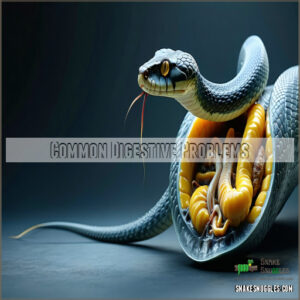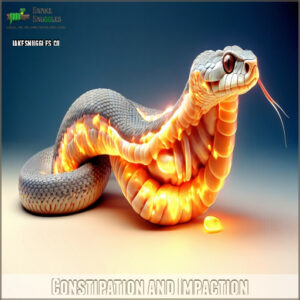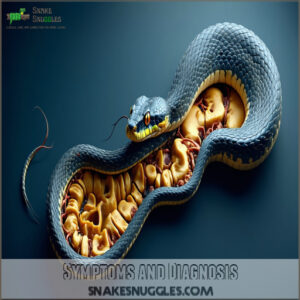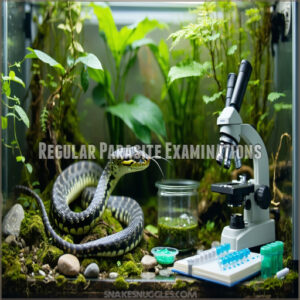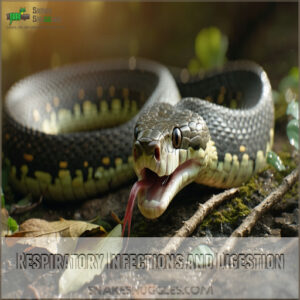This site is supported by our readers. We may earn a commission, at no cost to you, if you purchase through links.

Regurgitation, impaction, and intestinal blockages are just a few concerns.
By understanding these issues, you’ll be better equipped to prevent them.
It’s all about finding that "Goldilocks" zone – not too hot, not too dry – to keep your snake’s digestive system running smoothly, which involves proper feeding, clean enclosure, and avoiding temperature fluctuations.
Now, let’s get to the bottom of what’s really going on with your slithery friend’s stomach.
Table Of Contents
- Key Takeaways
- Snake Digestive Issues
- Common Digestive Problems
- Signs of Digestive Distress
- Causes of Impaction
- Intestinal Parasites and Worms
- Respiratory Infections and Digestion
- Recognizing Digestive Issues
- Preventing Digestive Problems
- Treating Digestive Issues
- Maintaining Snake Health
- Frequently Asked Questions (FAQs)
- Why does my snake have poor digestion?
- What problems does a pet snake have?
- Do snakes have health problems?
- Can Snakes get constipated?
- How do you know if a snake has health problems?
- What diseases does a pet snake have?
- What are the most common diseases in snakes?
- What are the symptoms of IBD in snakes?
- What does a constipated snake look like?
- How do I know if my snake has parasites?
- Conclusion
Key Takeaways
- You’ll want to monitor your snake’s digestion closely, as issues like regurgitation, impaction, and constipation can be triggered by temperature and humidity fluctuations, improper feeding, or poor enclosure cleanliness.
- To prevent digestive problems, you should maintain a proper enclosure setup, provide a balanced diet with adequate hydration, and schedule regular veterinary check-ups to catch potential issues early on.
- You can identify health problems in your snake by monitoring its appetite, stool, and overall behavior, watching for signs like lethargy, regurgitation, or unusual droppings that may indicate an underlying issue.
- If you notice any digestive issues, you should take prompt action, as they can quickly become serious if left untreated, and consider consulting a vet for guidance on treatment options, including antibiotics, dietary changes, and enzyme supplements.
Snake Digestive Issues
Your snake’s digestive health plays a huge role in its overall well-being, and getting it right isn’t as tricky as it seems.
By understanding how factors like temperature, humidity, and proper feeding schedules affect digestion, you can help your scaly friend thrive.
Temperature and Humidity Effects
Digestive issues in reptiles often stem from temperature fluctuations and humidity swings.
Without proper temperature regulation or stable humidity levels, your snake’s digestive system can hit a wall.
Keep thermal gradients steady and make certain moisture levels match their natural habitat.
Unstable heat sources or improper humidity can lead to slowed digestion—or worse.
Think Goldilocks: not too hot, not too dry!
Feeding Schedules and Prey Size
Getting feeding times right isn’t rocket science, but it’s essential for avoiding snake digestive problems.
Stick to these guidelines:
- Match prey size to your snake’s girth.
- Space meals based on species-specific meal frequency.
- Use high-quality prey items for snake nutrition.
- Avoid overfeeding – it triggers digestive issues in reptiles.
- Watch for feeding refusal; it signals potential feeding problems in snakes.
Environmental Factors and Cleanliness
When your snake’s home isn’t spotless, it’s like inviting trouble over for dinner.
Enclosure cleaning keeps bad bacteria away, while substrate safety prevents accidental ingestion.
Watch out for stagnant humidity levels or poor ventilation systems—they’re digestion disruptors.
Maintain the right environmental temperature and a steady temperature gradient—snakes thrive with proper housing.
Clean water? Non-negotiable for water quality and health.
| Factor | Problem Caused | Solution |
|---|---|---|
| Dirty Enclosure | Bacterial infections | Regular cleaning schedule |
| Poor Ventilation | Impaction, digestion issues | Install appropriate vents |
| Unsafe Substrate | Blockages | Use reptile-safe bedding |
| Humidity Levels | Mold, dehydration | Use a hygrometer to track |
| Bad Water Quality | Illness, dehydration | Change water daily |
Common Digestive Problems
In the context of snake digestive problems, it’s like a game of clues—you’ve got to know what to watch for.
Intestinal blockages, snake regurgitation issues, and constipation are key culprits affecting reptile digestive health.
Feeding tips matter: offering prey that’s too large can lead to stomach issues, while poor hydration messes with gut health.
Sometimes, your snake just needs smoother movements; think about proper humidity for snake constipation relief.
And hey, don’t forget Snake Nutrition 101—balancing meals keeps their digestive enzymes working like a charm.
Small enclosures or dirty habitats can add stress, making digestion tougher; give your snake room to slither, keep things clean, and you’ll prevent a heap of reptile digestive health woes.
Understanding digestive system diseases is essential for maintaining your snake’s overall health.
Signs of Digestive Distress
When your snake’s digestion isn’t working right, you’ll notice things like regurgitated meals, bloating, or even constipation.
Spotting these signs early can make a huge difference in keeping your scaly friend healthy and comfortable.
Regurgitation and Vomiting
Ever seen your snake spit food back up?
Regurgitation patterns or vomiting could point to stomach issues or stress.
Common vomit causes include poor temperatures or oversized prey.
Incorrect temperatures can lead to regurgitation in snakes.
Watch for these signs:
- Undigested food (regurgitation).
- Partially digested vomit.
- Rapid weight loss.
- Handling too soon post-feeding—big mistake!
- Low temperatures stopping digestive enzymes.
Keep the habitat cozy to avoid regurgitation.
Constipation and Impaction
Monitoring bowel movements in your scaly friend could prevent serious intestinal obstruction issues.
When you notice a swollen belly region, lack of defecation, or straining during bowel movements, you’re likely dealing with gut stasis.
Changes in bowel movements, including reduced frequency, altered consistency, or unusual odor, can indicate snake constipation problems.
Don’t brush off digestive blockages or fecal impaction – these conditions need immediate attention.
Your reptile vet can provide proper treatment before complications develop.
Loss of Appetite and Weight Loss
If your snake hasn’t eaten for several feeding cycles, you’re right to worry.
A drop in appetite often pairs with weight loss, turning your robust reptile into more of a noodle shape.
Check for dehydration signs like sunken eyes and sticky saliva.
Common culprits behind feeding refusal include parasites, respiratory infections, or stress from environmental changes – all of which can trigger starvation response and malnutrition.
Causes of Impaction
Your snake can develop impaction when it swallows substrate like sand or gravel, or if you’re feeding prey that’s too large for its size.
If you notice your snake hasn’t pooped in weeks or seems bloated, you’ll want to check the enclosure setup and feeding routine since these common mistakes can quickly turn your slithery friend’s digestive system into a traffic jam.
Ingested Substrate and Foreign Objects
Impaction often happens when your snake swallows something it shouldn’t, like debris or sand, leading to a gut obstruction.
To prevent this:
- Avoid loose substrates that cause substrate blockage.
- Keep enclosures clean of foreign bodies.
- Use non-toxic bedding materials.
- Hydrate your snake to avoid intestinal blockages.
- Research your snake’s habits to reduce object ingestion risk, which can lead to a serious intestinal blockage.
This set of instructions is crucial for snake owners to follow in order to maintain their pet’s health and prevent potential life-threatening conditions.
Oversized Prey and Feeding Issues
Feeding oversized prey can lead to serious snake feeding disorders like intestinal blockages or regurgitation.
Stick to proper prey size limits to avoid feeding errors.
Snakes swallowing meals too large may suffer impaction or feeding refusal.
Check out this quick table for guidance:
| Snake Size | Prey Size Recommendation | Frequency |
|---|---|---|
| Hatchlings | Pinky mice | 5-7 days |
| Juveniles | Small mice | 5-7 days |
| Adults (small) | Large mice/small rats | 7-10 days |
| Adults (medium) | Medium rats | 10-14 days |
| Adults (large) | Large rats | 14 days |
Proper feeding techniques balance snake nutrition and prevent problems with serious disorders.
Metabolic and Dietary Factors
Feeding oversized prey isn’t the only cause of snake gastrointestinal issues—metabolic and dietary factors play a big role too.
When nutrient balance is off, or the meal lacks proper food quality, problems sneak in.
- Low energy intake slows their metabolic rate, leading to reptile digestive disorders.
- Poor diets can trigger nutritional disorders reptiles face.
- Digestive enzyme supplements often help process meals.
Intestinal Parasites and Worms
You’ll want to keep an eye out for intestinal parasites and worms, which can harm your snake’s digestive system and cause symptoms like weight loss and diarrhea.
If you notice visible worms or other signs of infestation, it’s vital to take action and consult a vet to prevent further complications and guarantee your snake’s overall health.
You should prioritize this to ensure your snake does not experience severe complications.
Symptoms and Diagnosis
You’ll notice digestive alerts in your snake’s behavior, such as regurgitation or constipation, prompting health checks.
Diagnostic tools and medical tests help identify snake digestive issues, including reptile digestive disorders, to address digestive system issues and provide snake constipation relief.
All of these efforts are essential for managing snake regurgitation issues.
Treatment and Prevention Methods
If your snake has unwelcome guests in its gut, your vet might prescribe antiparasitic medications or recommend dietary adjustments to evict these freeloaders.
Restoring gut health is key, so probiotic use might be suggested.
Effective snake parasite treatment often involves anthelmintics and supportive care.
Here’s your action plan:
- Administer prescribed medical interventions.
- Implement necessary dietary adjustments.
- Consider probiotic use for improved gut health.
- Provide therapeutic care as directed by your vet.
Regular Parasite Examinations
You’ll want to schedule regular parasite exams, including fecal analysis and microscope exams, to check for intestinal parasites, using deworming methods to prevent parasitic infections in reptiles, reducing parasite burden.
The following methods are used for parasite control:
| Method | Frequency | Purpose |
|---|---|---|
| Fecal | Monthly | Detects parasites |
| Microscope | Quarterly | Identifies protozoan |
| Deworming | Bi-annually | Prevents infection |
The purpose of these exams is to ensure the health and well-being of reptiles by reducing parasite burden.
Respiratory Infections and Digestion
You’ll want to understand how respiratory infections can affect your snake’s digestion, as they can slow down metabolism and reduce nutrient absorption.
By recognizing the signs of respiratory infections, such as wheezing or lethargy, you can take prompt action to support your snake’s recovery and prevent further digestive issues.
This understanding is crucial for maintaining your snake’s overall health, particularly in preventing the worsening of digestive issues.
Effects on Metabolism and Nutrient Absorption
You’ll see many snake digestive health issues stem from impaired nutrient uptake, affecting metabolic rate and energy balance.
Digestive enzymes play a key role in absorption rates, influencing gut health and overall nutrient balance.
This balance is essential for preventing reptile digestive enzymes and digestive health problems, particularly those related to digestive enzymes.
Signs of Respiratory Infections
A stuffy snake is a sad sight, and respiratory infections are a common culprit.
Keep an eye out for these signs of respiratory trouble:
- Dyspnea (breathing difficulty): Notice if your snake takes longer than usual to inhale or exhale, or if its breathing rate increases.
- Open-mouth breathing: This is a red flag. Snakes usually keep their mouths closed when breathing.
- Mucus buildup: Any discharge around the mouth or nose warrants concern.
- Pneumonia signs: Listen for rattling or wheezing sounds, indicating fluid in the lungs.
- Respiratory failure: If left untreated, breathing problems can progress to respiratory failure and, sadly, death.
Treatment and Recovery Strategies
You’ll work with a vet to create a treatment plan, possibly including medication therapy, fluid therapy, and nutrient support.
To help your snake recover from respiratory infections, which can lead to issues like constipation or impaction, and impact digestive health, requiring reptile digestive enzymes and supplements.
Recognizing Digestive Issues
You’ll want to recognize digestive issues in your snake early on, as they can quickly become serious if left untreated.
By paying attention to changes in your snake’s behavior, appetite, and stool, you can catch potential problems before they escalate into major health issues.
Abnormal Behavior and Appetite Changes
You notice abnormal behavior and appetite changes in your snake, such as loss of appetite or refusal to eat, indicating potential digestive health issues.
Often, these issues are triggered by stress factors, affecting feeding cues and appetite stimulation.
This can alter normal behavioral patterns.
Visible Signs of Distress and Disease
Besides changes in behavior and appetite, snakes may exhibit several visible digestive warning signs.
Keep an eye out for these red flags:
- Discoloration: Skin color changes, such as darkening or pale patches, can indicate liver or respiratory issues.
- Lesions: Open sores or wounds on the body may suggest a bacterial infection or skin disease.
- Swelling: A bloated appearance could mean impaction or blockage.
- Discharge: Any unusual fluid, especially around the mouth or nose, may signal a respiratory infection.
- Lethargy: Prolonged inactivity, sluggishness, or lack of interest in surroundings can point to illness.
Importance of Veterinary Care
You’ll need veterinary care for snake digestive health issues.
The care plans for snake digestive health include regular check-ups, dietary advice, and consulting a reptile veterinarian.
| Care Plans | Medical Diagnosis | Preventive Measures |
|---|---|---|
| Regular check-ups | Stool tests | Hydration |
| Dietary advice | Endoscopy | Clean enclosure |
| Reptile veterinarian | Blood work | Balanced diet |
Preventing Digestive Problems
You can prevent digestive problems in your snake by maintaining a proper enclosure setup and providing a balanced diet with adequate hydration.
By following these simple steps and scheduling regular veterinary check-ups, you’ll be well on your way to keeping your snake’s digestive system healthy and happy.
Proper Enclosure Setup and Maintenance
So, you’re a snake parent, huh? Creating the perfect home for your slithery friend is key to their health.
Here’s how to set up a safe space:
- Enclosure Design: Go for a glass tank with a screen lid for ventilation. Size matters—your snake’s home should be long enough for their full stretch and wide enough for some twists and turns.
- Ventilation Systems: A must for fresh air and humidity control.
- Substrate Options: Pick a substrate that’s absorbent and easy to clean. Aspen shavings or reptile carpet are good choices to keep things dry and clean.
Proper snake enclosure designs are essential for maintaining a healthy environment.
Balanced Diet and Hydration
You guarantee your snake’s digestive health by providing a balanced diet with nutrient balance, varied food, and proper hydration methods, supporting gut health and snake digestive enzymes with dietary supplements for peak digestive health.
Additionally, using the right snake food supplements can help maintain a healthy digestive system in snakes, which is crucial for their overall well-being and requires careful consideration of digestive health.
Regular Veterinary Check-ups
You schedule regular veterinary check-ups to prevent reptile digestive issues.
Consider:
- Annual snake exams
- Updating health records
- Checkup schedules with a reptile veterinarian for proper snake digestive system care and veterinary consultations to maintain ideal snake health.
Regular check-ups help identify digestive health issues early on, which is crucial for reptile digestive issues, snake health, and digestive health issues.
Treating Digestive Issues
You’re taking the right step by seeking treatment for your snake’s digestive issues, and this is a key part of determining the best course of action.
By understanding the treatment options, including antibiotics, dietary changes, and enzyme supplements, you can help your snake recover from digestive problems and prevent future issues.
Antibiotics and Antiparasitic Medication
You’re now considering antibiotics and antiparasitic medication to treat digestive issues.
The following table outlines the medications, their uses, and risks associated with bacterial resistance:
| Medication | Parasite Treatment | Bacterial Resistance |
|---|---|---|
| Metronidazole | Giardiasis | Low risk |
| Ivermectin | External parasites | Moderate risk |
| Others | Various | High risk |
The information provided is crucial for understanding the treatment options and their associated bacterial resistance risks.
Dietary Changes and Enzyme Supplements
You’re moving beyond antibiotics, now focusing on dietary changes and enzyme supplements.
Key considerations include:
- Enzyme Therapy
- Dietary Shifts
- Supplement Timing, for ideal snake gut health and nutrient balance, addressing digestive disorders with digestive health supplements.
Understanding enzyme functions requires knowledge of digestive enzyme supplements, which is crucial for digestive health.
Surgery and Emergency Care
You’re now facing surgery and emergency care for your snake’s digestive issues, possibly due to foreign object obstruction or fecal impaction.
The care options can be outlined in the following table:
| Surgery | Emergency Care |
|---|---|
| Anesthesia | Wound Care |
| Surgical Tools | Post Op Recovery |
| Emergency Procedures | Bowel Movement |
This table highlights the different aspects of emergency care that you should consider for your snake’s digestive health.
Maintaining Snake Health
You play a vital role in maintaining your snake’s health by ensuring its environment is clean and well-maintained.
By monitoring your snake’s behavior and health status, you can catch potential digestive issues early on and take action to prevent more serious problems from developing, which is crucial for maintaining your snake’s overall well-being.
Optimal Temperature and Humidity Levels
You’ll want to maintain ideal temperature and humidity levels, using thermal gradients and humidity control to mimic your snake’s natural environment.
Minimizing temperature fluctuations and ensuring proper moisture levels is crucial, with heat sources and humidity control working together to create a healthy space.
The goal is to create an environment where humidity control and temperature regulation work in harmony, ensuring the well-being of your snake.
Clean Environment and Hygiene Practices
You keep your snake’s enclosure clean by following proper sanitation methods.
- Disinfectant use
- Waste removal
- Cleaning schedules
- Hygiene protocols
These practices are crucial for maintaining a healthy environment, and they also support proper digestion habits to prevent snake constipation relief and promote reptile stomach care and digestive health.
Monitoring Behavior and Health Status
You monitor your snake’s behavior and health status by tracking activity, watching for signs like weight loss or shedding issues, and checking for behavioral alerts, ensuring overall snake health and digestive health, and preventing common snake ailments through regular health checks and observation.
The health of your snake can be indicated by several signs, including loss of appetite, constipation, and aggression, which are often caused by poor diet, inadequate hydration, and hunger, respectively.
| Sign | Cause | Prevention |
|---|---|---|
| Loss of appetite | Poor diet | Balanced meals |
| Constipation | Inadequate hydration | Proper watering |
| Aggression | Hunger | Regular feeding |
To maintain your snake’s health, it is crucial to address these signs promptly by providing balanced meals, ensuring proper watering, and maintaining a regular feeding schedule to prevent these issues from arising.
Frequently Asked Questions (FAQs)
Why does my snake have poor digestion?
You’re likely noticing your snake’s poor digestion due to inadequate temperature, humidity, or feeding habits, which can cause stomach issues and discomfort in your pet snake.
What problems does a pet snake have?
What’s slithering into your worries? You’ll face issues like regurgitation, impaction, and metabolic bone disease if you don’t provide proper care for your pet snake.
Do snakes have health problems?
You’ll find that snakes can indeed have health problems, including respiratory issues, parasites, and metabolic problems, which you can manage with proper care and attention.
Can Snakes get constipated?
Notably, you’re wondering if snakes get constipated, and yes, they can, due to dehydration, poor diet, or obstruction, causing discomfort and health issues, just like in humans, pretty ironic, right?
How do you know if a snake has health problems?
You can identify a snake’s health problems by monitoring its appetite, stool, and overall behavior, watching for signs like lethargy, regurgitation, or unusual droppings that may indicate an underlying issue.
What diseases does a pet snake have?
Like a puzzle, your pet snake’s health can be tricky.
But you’ll uncover diseases like respiratory infections, mites, and scale rot, which can impact their overall well-being and require prompt veterinary care.
What are the most common diseases in snakes?
You’ll commonly see respiratory issues, parasites, and skin infections in snakes, so it’s imperative to monitor their health and seek veterinary care if you notice any unusual symptoms or behaviors.
What are the symptoms of IBD in snakes?
You’ll notice symptoms like regurgitation, diarrhea, and weight loss in snakes with IBD, a gastrointestinal disease that’s a real hiss-terical health concern for these slithery creatures, affecting their overall well-being.
What does a constipated snake look like?
You’ll see a constipated snake struggling to pass feces, with a swollen belly, lethargy, and decreased appetite, indicating a potential blockage or impaction that requires immediate veterinary attention and care.
How do I know if my snake has parasites?
You’ll know if your snake has parasites if it shows weight loss, lethargy, or regurgitation.
So monitor its behavior, stool, and overall health closely for these red flags and consult a vet.
Conclusion
Notably, 75% of snake owners encounter digestive issues.
You’re now better equipped to tackle common snake digestive issues by understanding signs, causes, and prevention tips, ultimately keeping your pet healthy and thriving.
This understanding is essential for preventing and managing common snake digestive issues, particularly by recognizing the signs.
- https://veteriankey.com/diseases-of-the-digestive-system-4/
- https://www.myfamilyvets.co.uk/snake-health-problems
- https://animals.mom.com/happens-snake-doesnt-digest-food-8366.html
- https://campus.murraystate.edu/faculty/tderting/cva_atlases/copsnake/digestsyssnake.htm
- https://www.pangeareptile.com/collections/uvb-bulbs-florescent-mercury-vapor


